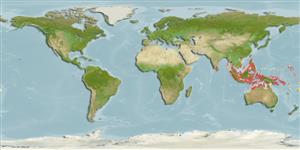Common names from other countries
Environment: milieu / climate zone / depth range / distribution range
Ecologia
; intervalo de profundidade 0 - 20 m (Ref. 96968). Tropical
Indo-West Pacific: Indo-Malayan Archipelago.
Length at first maturity / Tamanho / Peso / Idade
Maturity: Lm ? range ? - ? cm Max length : 23.0 cm TL macho/indeterminado; (Ref. 96968)
Mantle length is 3.6 cm. This species is frequently confused with the mimic octopus (Thaumoctopus mimicus) which co-occurs in similar tropical habitats. Some aquarium trade occurs for this species. Its high tourism, photography and documentary profile shows its significant commercial value alive especially in Bali and northern Sulawesi, Indonesia (Ref. 96968). This species has been encountered primarily on soft sediment substrates where it occupies burrows in deep sand. Individuals were found to occupy the same burrow for periods of at least three weeks. This species appears to have a crepuscular activity pattern, emerging to forage during half-light periods at dusk and dawn (Ref. 96968). Feeds on small crustaceans and fishes (Ref. 7937).
Life cycle and mating behavior
Maturidade | Reprodução | Desova | Ovos | Fecundidade | Larvas
Members of the class Cephalopoda are gonochoric. Male and female adults usually die shortly after spawning and brooding, respectively. Mating behavior: Males perform various displays to attract potential females for copulation. During copulation, male grasp the female and inserts the hectocotylus into the female's mantle cavity where fertilization usually occurs. Life cycle: Embryos hatch into planktonic stage and live for some time before they grow larger and take up a benthic existence as adults.
Hochberg, F.G., M.D. Norman and J. Finn. 2006. (Ref. 7937)
Categoria na Lista Vermelha da IUCN (Ref. 130435)
Categoria CITES (Ref. 108899)
Not Evaluated
Not Evaluated
Ameaça para o homem
Harmless
Utilização humana
| FishSource |
Ferramentas
Mais informação
Idade/Tamanho
Crescimento
Comprimento-peso
Comprimento-comprimento
Morfologia
Larvas
Abundância
Fontes da internet
Estimates based on models
Preferred temperature
(Ref.
115969): 27.9 - 29.3, mean 28.8 (based on 1313 cells).
